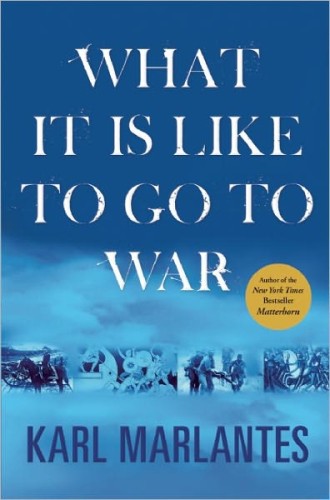What war does to warriors
It seemed that nothing, absolutely nothing could stack up against the intensity of war and war's friendships. I felt only intensely empty."
Readers of Karl Marlantes's novel Matterhorn will recognize why war is so compelling for Marlantes, as well as why life after war seems so empty. For in spite of the brutality depicted in the novel, the reader cannot but become mesmerized by the beauty of battle that Marlantes so graphically describes. At times I had to force myself to stop reading Matterhorn because I was enthralled by the sheer horror in his account of the Vietnam War.
What It Is Like to Go to War is the sequel to Marlantes's novel. I call it a sequel even though it is not a novel. Rather, it is perhaps best understood as a commentary on the novel. Many of the events described in Matterhorn reappear in this second book, making it clear that much of the novel is a fictionalized account of Marlantes's experiences in Vietnam as a lieutenant in the Marine Corps. That takes nothing away from the novel, but it does mean that these books need to be read together. In What It Is Like to Go to War Marlantes explicitly develops the suggestion in the novel that war provides a sense of transcendence and integrity that can be found nowhere else in our lives.
Read our latest issue or browse back issues.
As many other stories suggest, war makes possible a bond between warriors that is absent in most of our lives. For example, in Matterhorn, Marlantes describes an assault in which his men came under withering fire while ascending a mountain. Some of his men dropped to the ground, afraid to go farther. But, Marlantes tells us:
The attack went on—not because of any conscious decision, but because of friendship. Jackson went running forward, more to see if Fracasso was alive than for tactical reasons. Vancouver saw Jackson heading for the lieutenant and decided that even if the platoon were in a hopeless shit sandwich he'd be goddamned if he let Jackson run forward alone. So he kept going. Connolly, seeing Vancouver charging forward, did exactly the same, although his mind cried out to him to merge with the great welcoming earth beneath his feet. He wouldn't abandon a friend to go it alone. Neither would any of the others.
Marlantes suggests that the bond between warriors—a bond that at times could even transcend the racism so present in the military culture in Vietnam—is forged by the most determinative reality of war: warriors may actually find that they enjoy killing. He observes that "there is a deep savage joy in destruction, a joy beyond ego enhancement." Though Marlantes acknowledges that transcendence can be achieved in certain modes of creativity, he argues that in war it is far easier to take the path of transcendence through destruction. He confesses, "There's part of me that just loves maiming, killing, and torturing." That part is not all of him; if it were, he could not have written this book. But it is certainly there.
His experience in Vietnam means that it will always be there. Marlantes is a member of an exclusive club: the club of warriors. The club is constituted by a code of silence in which tales of horror, tales that are filled with transcendence made possible through the constant presence of death, are told only to other members of the club because only they have shared the horror as well as the love of killing. But membership in the club also brings isolation from those whom they allegedly served by going to war.
Marlantes confesses that he has written this book 40 years after his Vietnam experience in an attempt to come to terms with his experience of combat. One suspects that he wrote Matterhorn for the same reason. He acknowledges that he could have kept his thoughts in a personal journal, but he has published the story in the hope that other combat veterans will be better able to integrate their combat experience into their lives. For, as he notes, the silence that surrounds those who have suffered the violence of war relates not only to the violence that was inflicted on them but also to the violence they inflicted on others.
He writes, therefore, as a moralist determined to break the silence that surrounds the work of war—that is, the work of killing the enemy before the enemy kills you. He is trying to help those who have not experienced war to understand that the deepest challenge of war is the killing. The problem, according to Marlantes, is quite simple: the Marine Corps taught him how to kill, but it did not teach him how to deal with killing.
Killing affects warriors, Marlantes observes, because it was drilled into them from childhood that they should not kill. This is why the warrior will almost always kill with the conviction—developed by basic training that aims at eliminating the enemy's humanity—that at the time of the killing the enemy is not human. Yet later, when life returns to normal and the warrior remembers killing a young enemy soldier who couldn't have been more than 25, he cannot repress the thought that he could have been killing his own son.
Marlantes stresses how important it is for those who have been transformed by battle—a transformation that he thinks bears all the marks of a religious conversion—to have someone to whom they can return. He observes that you cannot expect a normal 18-year-old to kill someone and contain it in a healthy way. Warriors know how much pain they have caused and how much evil they have done, so cheering for them is equivalent to cheering for a surgeon who has amputated a leg to save a life. What is needed is a community that can receive them back with a sadness appropriate to the acknowledgment that they have killed other human beings. Marlantes confesses that he has finally reached a place where he no longer feels guilty about having killed to help or save a fellow marine. He simply feels sad. It is this sadness that he thinks must become part of the formation of those we will send to kill for us in the future.
Marlantes is no pacifist. He thinks that sides must be chosen. He supported the decision to go to war to kill Osama bin Laden and to remove Saddam Hussein. These were loathsome tasks that conscientious persons had to perform. Yet the question is how those so called to be warriors can perform the violence they must enact and still maintain their humanity. How do you train 18-year-olds to kill without releasing the dark warrior of Mars, the god of war? Marlantes offers no simple solution, but he does think that warriors must receive some form of spiritual training.
Even more important, Marlantes thinks that we need a new mythology about war itself. In war, one is constantly aware of the inevitability of one's death, as well as constantly focused on the present moment. Warriors even value the lives of others over their own because they think that they are part of a larger community that makes intelligible their killing and dying. If we are to be saved from the appeal of war, transcendence and intensity must come through other means. The substitute for war is not peace but love, art and creativity. According to Marlantes, at the very least future warriors must know the people in whose name they kill.
I am a pacifist. Some might suspect that I am calling attention to Marlantes's work in order to cast doubt on his justifications of war because of the brutality of war. However, I have always thought it a mistake to use the terror that war is as an argument against war. We live in a dangerous world. We cannot ignore the reality that those committed to nonviolence may have to watch the innocent suffer for their conviction. The reason I think work like Marlantes's is so important for pacifists and just warriors alike is that I recognize the hard-won humanity represented by his determination to help us comprehend the reality of war. If Christians can ever hope to be a people who are so intense that we may be an alternative to war, we cannot be less human than those who, like Marlantes, have refused to justify what they have had to do in battle.






